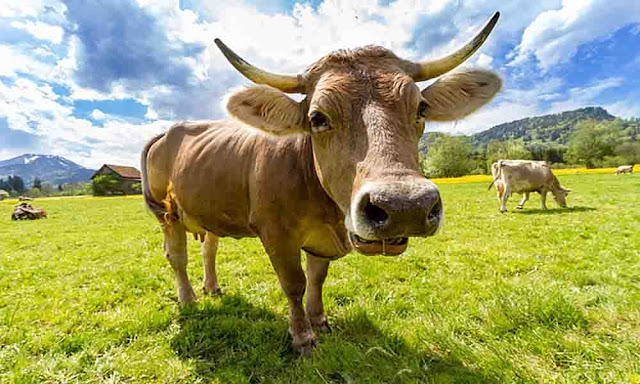Nepal is one of those countries that everybody's heard of but no one knows enough about even its very name sounds exotic and people like hearing about it, but exactly how much do you actually know about this country? Can you believe that Nepal was never colonized? The capital of Nepal has more UNESCO world heritage sites than any other city. Nepal has never officially won an Olympic Games Medal. Nepal is a land lock country that means it has no direct contact with the Sea. Out of many amazing facts, here are the top 10 amazing facts about Nepal.
10. Non Quadrilateral flag
Nepal's flag wins the uniqueness award because of its shape, it's the only non-quadrilateral flag in the world. It's basically like to join triangles with the bottom triangle having its top cut off. The flag of Nepal was accepted on December 16th, 1962 and to this day it has remained one of the most recognizable symbols of the country. The blue color on the border symbolizes the national unity of the country. While the crimson red stands for the courage of the Nepali people in general. The Sun and the moon are there to symbolize bravery and peacefulness these two are also there to say how Nepal will exist as long as the Sun and the moon exist.
Nepal is home to many of the world's tallest mountains. Out of the top 10 tallest mountains in the world 8 are in Nepal. The tallest mountain in the world Mount Everest also belongs to Nepal. The total height of Mount Everest is 8848 meters. Many mountain Climbers around the world come to Nepal to conquer this huge mountain. Many of them have lost their lives during the conquest of the world's tallest mountain and many have successful to conquer it. In 2009 Nepali government also held the world's highest cabinet meeting at the base camp of Mount Everest.
8. Nicknamed the weed capital
Nepal was the so-called hippie trail, it was a route from Europe all the way to the Far East. It was extremely popular in the 1960s with the birth of counterculture many young people flocked to Asian countries in pursuit of adventure. Many of the roads led through Nepal and the cannabis economy flourished. It was so massive that you could literally buy the stuff everywhere. But once the government saw what they considered to be the disruptive power of the drug economy it put it all to an end in 1973. All the cannabis shops and farms had their licenses canceled and the dealers were banned from conducting their activities. Nowadays it is legal to smoke hashish but only during the Hindu festival of Maha Shivratri.
7. World's second-slowest internet
About 60% of internet users in Nepal surf the internet with a speed below 256 kbps. It is the second slowest speed in the world. The Internet was introduced to Nepal back in 1994 but its development has been quite slow. The commercial internet packages are decently fast or acceptable but the bigger problem is with domestic and personal packages. The internet speed depends a lot on the actual price you pay on a monthly basis. Not only the speed also the percentage of internet users in Nepal is very low. According to research completed in 2010 only around 20 percent of Nepal's population uses the Internet. The situation has been improving gradually over time and more and more internet providers are finally entering the game.
6. Languages of Nepal
Many people don't know this but Nepal has more than 100 local languages, in fact, the exact number is 123. With over 100 smaller languages we can clearly say Nepal is the linguistic gem of the world. The official language of Nepal is Nepali which was known in the past as cascara or Gorkhali. This language is actually a descendant of the ancient Sanskrit language and it now serves basically as the lingua franca of the whole region of Nepal. It's spoken by around 17 million people. The second-largest language in Nepal is Maithili and it's also one of the largest languages spoken in India. In Nepal, around 10% of the people speak Maithili. The other languages to mention Bhojpuri, Tharo, and Tamang all of which have over 1 million speakers.
5. The only living goddess Kumari
The word Kumari comes from the Sanskrit language and it could be translated as a princess in Nepal. Kumari is a prepubescent female who was selected from a specific group in the Newari community in the Shakya caste. This is the tradition of worshiping divine female energy resting in the girl's body. To qualify to be chosen, the girl has to be in perfect health and has never been sick. She must possess all of her teeth and she must be a prepubescent virgin, but these qualifications are just to pass round one. After round one things get even tougher the next round includes looking for signs of divinity in a girl, such as the eyelashes of a cow or the thighs of a deer. The goddess's hair must be black. Finally, when a girl has chosen to assume the energy of the goddess, there comes the final test, she must be a knight in a ritual room that's filled with the heads of many slaughtered animals but she cannot show any sign of fear. The girl will remain the reincarnation of the goddess until she gets her first period because at that moment it is assumed that the divine energy left her body.
4. Ethnic groups
With the population of just over 25 million people, Nepal is definitely not a small country sure it's not the biggest but it's probably a lot more than you thought. The interesting thing about Nepal is that the people in this country define themselves as primarily Nepali's. They mainly come from two groups Indo-Aryan and Sino-Tibetan. In addition to these, there are many more nationalities and ethnic groups, but all of them identify as Nepali's. Because there are so many languages and so many ethnic groups, inhabitants of Nepal do not make the correlation between their ethnicity and nationality as it would make a whole lot of mess. Instead, people identify themselves as Nepali's through citizenship and allegiance
3. The cow is a sacred animal
As you probably know that cow is considered a sacred animal in India, but it's the same in Nepal as the population is predominantly Hindu. In 2015 the cow was declared the country's national animal and it made it all the way to the Nepali's Constitution. After many years of political unrest, Nepal got a new constitution, and in it, the cow was declared sacred in respect of the Hindus, and all cow slaughter was banned. The interesting thing is that even on the practical side cows are a great help because they help to regulate traffic. Yes as funny as it may sound cows are allowed to walk freely down the streets of Kathmandu and without them traffic would be even more chaotic, but cows helped the traffic issue because they serve as road dividers.
Since there are so many nationalities and ethnic groups in Nepal it's safe to assume that there would be so many different customs and traditions and this is absolutely true. Nepalese people are in general quite friendly and they will greet a foreigner to their land, expressing interest in taking a picture with them, and showing them around traditional Nepal. Ease greeting is Namaste which can be translated as greetings to the divine inside of you which is truly wonderful. This is a sign of great respect, and when you want to greet someone like this you should hold your palms together like you're praying. When it comes to shopping it's even more interesting, if you want to agree with someone you should tilt your head a little bit if expressing disagreement. When you don't want to buy something or you don't want to go somewhere you should hold your hand up and swivel it a little and for pointing around don't use your finger instead of point with your chin. Also, food is not consumed from other people's plates once one person uses a plate it's theirs and theirs alone
1. Nepal was never colonized
Strange as it may seem Nepal was never a colonized country and it has managed to avoid all major military conflicts of the modern age. The reason for this lies in the fact that Nepal is located in a pretty special region and it's almost impossible to conquer it. Many have tried but without success, the only country that was close to conquering Nepal was the British Empire. During the Anglo Nepalese war of 1814 to 1816, the two countries were disputing over border issues, and in the end, Nepal was forced to give 1/3 of its territory to the British. But the country was never conquered as a whole the British had massive troops and they hit hard but Nepal's rugged terrain served as a buffer zone and the British were powerless large mountain chains repelled the British troops and Nepal was saved. It was much easier to sign a treaty with Nepal than to press on desperately. However, during the actual fighting, an interesting thing occurred the British officers were so impressed with the Nepalese Gurkha troops that they wanted to see them fighting on their side. These were Nepalese people of Indian Gurkha ethnic background as a result of their courage in combat many soldiers from the ranks of the Gurkha were reunited into the British colonial army spreading the name and courage of the Nepalese people.


























No comments:
Post a Comment